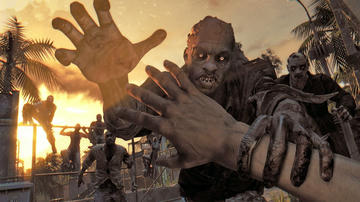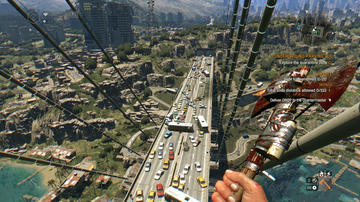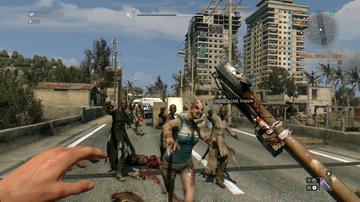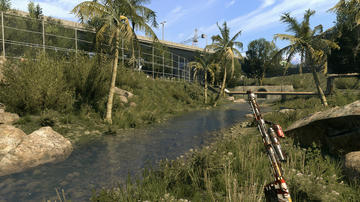Dying Light
Techland, 2015

Dying Light takes several steps forward from Techland’s previous zombie game, Dead Island. While the gameplay is similar, an engaging new parkour system gives you the freedom to explore every nook and cranny of a new and very dangerous open world.
Story and setting
The game is set in the fictional Turkish city of Harran, where a viral outbreak has turned much of the population into aggressive zombies. The city has been quarantined and the Global Relief Effort help remotely by airdropping relief packages into the city.
The player character is Kyle Crane, who is sent to Harran by the GRE to retrieve sensitive data from a rogue political figure, Kadir “Rais” Suleiman. Rais is blackmailing the GRE and is threatening to publish the data if they don’t give him what he wants. It’s a better story than Dead Island, with a darker and more mature tone, although it still feels clichéd and suffers from dodgy dialogue/voice performances.
Kyle Crane however does just about save this story: the voice actor plays him as a sarcastic, world-weary anti-hero and as the game progressed I actually found that I wanted to know more about him. The same couldn’t be said of any of the player puppets in Dead Island.
So if the story is better this time around, what about the gameplay?
Gameplay
Much of the Dying Light gameplay is very similar to Dead Island. Combat is still mainly focused on mêlée weapons (although gunplay is now much better), and you’ll be spending a lot of time up close and personal with the zombie horde. But two new mechanics raise this game into something even better: parkour and a dynamic day-and-night sequence.
Parkour
The parkour system elevates Dying Light, both literally and figuratively. Kyle Crane learns the skill early on and as the game progresses, he becomes world class at leaping up, on and over things. This may not sound like anything special, but it adds a whole new axis to the gameplay. Now you’re able to traverse the world vertically, and at speed. You’re not constrained to walking or running any more, and the freedom that all this leaping about affords is exhilarating.

You can shimmy up lamp-posts, jump from roof to roof, scale the sides of buildings and clamber up anything that looks vaguely climbable. Some of the tallest things in the game require you to scale them, from industrial cranes to a huge suspension bridge. And when you’re at the top, the sense of vertigo is immense. The last time I really felt that was clambering about under that bridge in Half Life 2.
Moving around these heights can be terrifying and more than once I ended up with sweaty palms as I tried to prevent Kyle from slipping to his death. It’s brilliant stuff and despite my vertigo, I was grinning broadly as I leaped around this open world.
Dynamic day/night cycle
If you think wandering about a zombie infested city during the day is bad, try doing it in the dead of night. Dying Light runs a day/night cycle that makes parts of the game truly terrifying. The day lasts for about an hour of real-time, the night is around 10 minutes. This might seem odd, but you really don’t want to be out there longer than that.

Leaping around the slums and the city at night is nerve wracking. Kyle must keep out of sight from volatiles, super strong zombies that you don’t stand a chance against until you’ve levelled up a few times and have better weapons. Some quests require you to go out and night and I got quite stressed by them - it’s no fun trying to complete a difficult quest in the dark in just a few minutes.
The ambience of the night sequences is also excellent. It’s quiet and still and there’s a sort of musical drone at a frequency that really put me on edge. Every now and then you’ll hear the strange snuffling sounds of a prowling volatile, and their howls and wails can make your neck hairs stiff. This is brilliant sound design and helps make the night gameplay a truly scary experience.
Combat and crafting
Mêlée combat is still the primary way to dispatch your enemies, whether zombie or human. The close combat is very similar to Dead Island, but it feels more realistic and nuanced. There are also now combos that you can perform; for example, leaping from a height with a weapon drawn will stab an unsuspecting zombie right through the chest as you land on it. Other combos can be learned as you progress through the game.
As with Dead Island, simple weapons can be found all over the game world, while better weapons can be bought from traders. All weapons can be customised in a similar way to Dead Island, and they also all break after a certain amount of use.

This time however you don’t need to pay cash to fix weapons at a crafting table. Instead, each weapon gets a number of ‘repairs’, and as long as you’ve collected enough spare parts to fix them, you can repair them at any time. I had a big gripe over the silly system for this in Dead Island and I’m glad this has been improved.
Blueprints give you the ability to customise weapons or create supplies, and can be found dotted around the world, or given to you as quest rewards. There’s a huge array of blueprints which give all sorts of benefits, and some of the more outlandish will grant you things like a wing suit, or stasis fields. You can spend hours just crafting things and seeing their effects.
Quests and exploration
The Dying Light story is played out as you undertake quests, much like Dead Island. In fact, there’s very little difference here at all. You’ll receive survivor points for completed quests, and sometimes you’ll also get new weapons or blueprints. Story quests are required for the game to progress, while side quests give you opportunities to get better weapons or learn more about Harran and how it fell.
The biggest improvement in the quest system is that all the characters you interact with now look much more real. The definition and clarity of the models is much improved and the lip-sync is better too. While I still wasn’t completely engaged with the story, at least those telling it looked human this time.

However, it’s not the predetermined story that shines in Dying Light. That’s all rather ho-hum and predictable. No, the real star of this show is the story that I made for myself. The huge open world is begging to be explored, and this is the part that I love. There’s nothing better than seeing a detail in the distance and wondering “How do I get over there?”. Or looking up at a tall radio tower and thinking “I wonder if there’s anything at the top?”.
Being able to go where you please and divert off the beaten track gives such a sense of freedom, and delivers moment-to-moment of unscripted story that I can claim as my own. Of course, to progress the game you still need to finish the expected quests, so the sense of freedom doesn’t last long, but when you’re out there, alone, climbing a pylon with a horde of virals after you, that’s when I felt the game really understood me and I was so pleased it left me alone to enjoy it in my own way.
Sound and visuals
The visuals of Dying Light are streets ahead of Dead Island. It’s still powered by Techland’s Chrome engine which has received a big upgrade. Everything looks more realistic and the attention to detail in some of the scenes is excellent. Although the colour palette is still washed out, it suits the tone of the game very well. It’s still not as good looking as the Crytek or Unreal engines, but once you’ve got into the vibe of this game you really won’t mind.

The sound design is fantastic. Daytime ambience really establishes a sense of place, and as already noted the eerie ambience of night-play is extremely creepy. Combat sounds satisfying and the voice acting is much better than Dead Island.
I must give special praise to the soundtrack. This is stunning and perhaps one of the most surprising aspects of the game. Old-school filtered synths paint an impression of dereliction and hopelessness, with the main theme suitably sparse but instantly memorable. The atmosphere created is unique and sounds so appropriate that it’s a perfect representation of the tone and theme of the game. When experienced in game, I was quite haunted by the music and it’s a huge part of the overall Dying Light experience.
Summary
I absolutely loved this game. It’s a huge step up from Dead Island and great fun to play. The new parkour system and the day/night cycle add fun, interest and genuine terror, while the huge array of weapons, items and blueprints add infinite variety to the combat and exploration.
There are still some niggling design issues in the constant re-spawning of enemies and loot, and I’d like to see a version of the game that disables all that when in single-player mode. I’d prefer a tighter, more dangerous single-player experience that doesn’t make concessions for co-op play, and I’m still dreaming of a Dying Light experience that offers true exploration without the constant gamification. But this is such a huge improvement over Dead Island, and I had so much fun with it, that I keep returning to it even after completing the main campaign.
Techland have done a great job with Dying Light and this game finally proves they’re more than capable of making a AAA game. I wonder what they will deliver next?